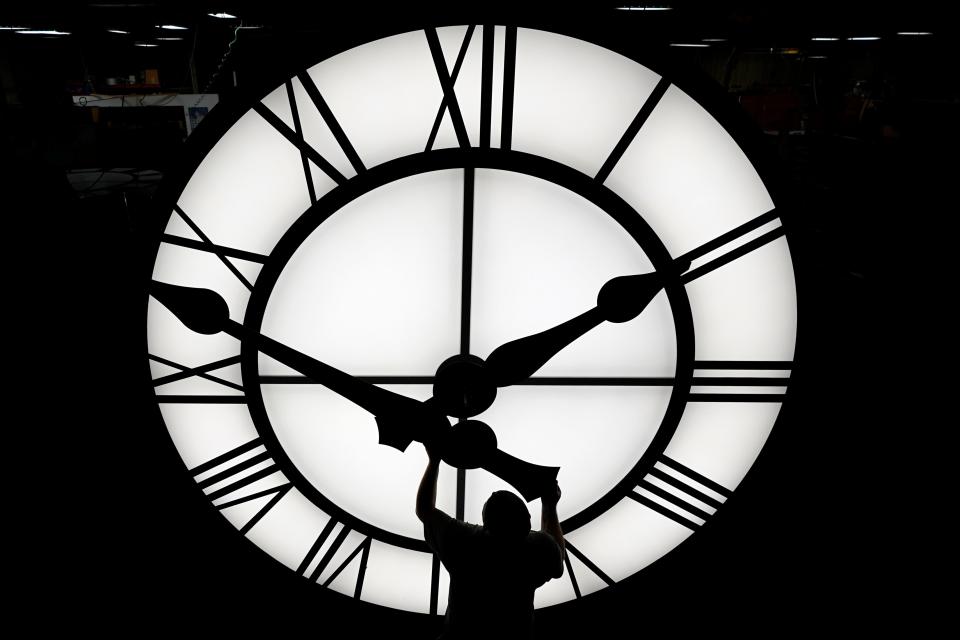Get ready to spring forward: Here's when daylight saving time 2023 begins
On the morning of Sunday, March 12, daylight saving time will once again commence.
Clocks will spring forward one hour at 2 a.m., and we'll lose that hour of sleep.
The tradeoff is that the sun will start setting after 7 p.m. in Oklahoma for the first time since October.
But why go through the trouble in adjusting clocks and circadian rhythms twice each year?
With the impending start of spring ― cue the budding flowers, the return of some birds to the region and shorts, at least for some ― here's a brief explainer on what daylight saving time is, how it started, and the effort by some states to make it permanent.
How did daylight saving time start?
The Uniform Time Act established nationwide standards for the observance of daylight saving time when it was signed into law in 1966.
Prior to then, daylight saving time in the United States was not regulated by the federal government, leaving municipalities, cities and states to decide whether or not to observe the practice, and if so, when it started and ended.
More:Is daylight saving time bad for your sleep schedule? Oklahoma doctors weigh in on health risks

The Robert C. Byrd Center for Congressional History and Education characterized this as a haphazard approach to managing the country's standard time, saying it left "transportation industries, including railroads, trucking and airlines, with complex and constantly shifting time schedules." And by the mid-20th century, the emerging broadcast television industry was finding it difficult to work within patchwork time zones and standards.
Since then, the start and end dates for daylight saving time in the United States has shifted over the years.
Who came up with daylight saving time?
The practice, at least according to Encyclopedia Britannica, was first suggested in an essay by Benjamin Franklin in 1784.
The first true proponent of daylight saving time, however, was an English builder named William Willet. In 1907, he published a pamphlet called "The Waste of Daylight" that campaigned for advancing clocks in spring and turning them back in fall, according to the National Museum of Scotland. Willet also encouraged people to get out of bed earlier in the summer to make the most of daylight.
"Everyone appreciates the long light evenings," Willett wrote in the pamphlet. "Everyone laments their shrinkage as autumn approaches, and nearly everyone has given utterance to a regret that the clear bright light of early morning during spring and summer months, is so seldom seen or used. Nevertheless standard time remains so fixed, that for nearly half the year the sun shines upon the land, for several hours each day while we are asleep."
Should the U.S. end daylight saving time?
No one actually likes losing or gaining an hour of sleep for the sake of more daylight, do they?
Recent polls have found that only 35% of Americans support resetting their clocks every fall and spring, while 59% want to see daylight saving time made permanent. And that sentiment appears to have translated to legislative action.
In the past five years, 19 states including Ohio have enacted legislation or passed resolutions to provide for year-round daylight saving time, if Congress were to allow such a change, and in some cases, if surrounding states enact the same legislation, according to the National Conference of State Legislatures.
The key phrase there is if Congress were to allow such a change.
Under the Uniform Time Act, states and territories have the power to opt out of daylight saving time and switch to standard time, which Arizona, Hawaii, Guam, American Samoa, Puerto Rico and the U.S. Virgin Islands have done.
If the country were to switch to year-round daylight saving time, Ohio would move to Atlantic Time, the time zone for Puerto Rico, much of the Caribbean and Canada's Maritime provinces.
So, despite what states want, a switch to year-round daylight saving time requires a change in federal law.
The U.S. Senate passed a bill last March that would have made daylight saving time permanent across the U.S. beginning this year. But the House of Representatives didn't take the Sunshine Protection Act up in subsequent months.
This article originally appeared on Oklahoman: Daylight saving 2023: Here's when we spring forward in Oklahoma

